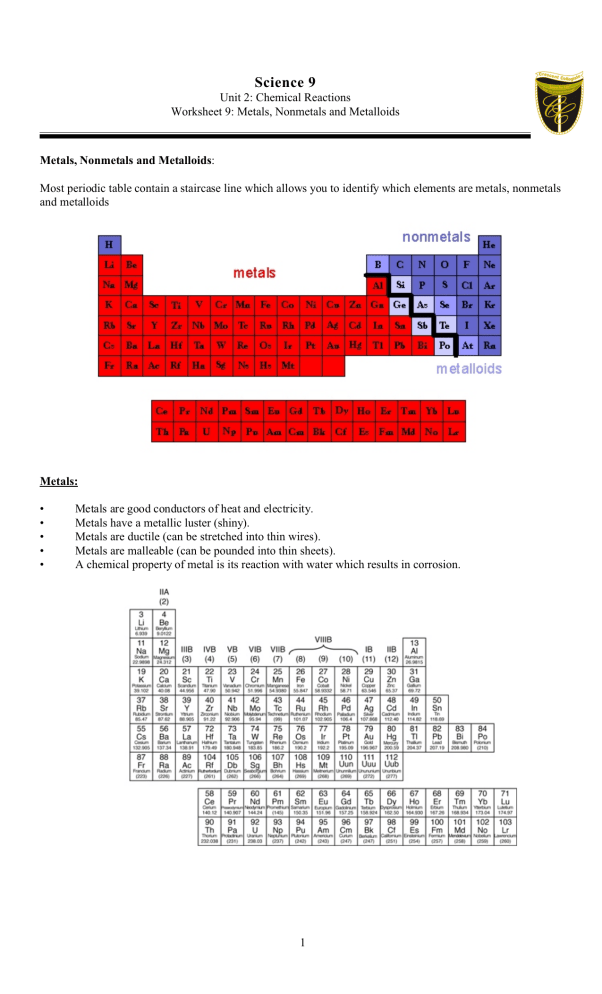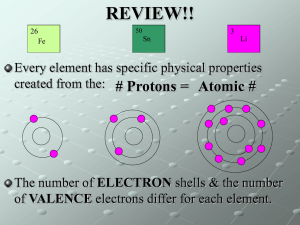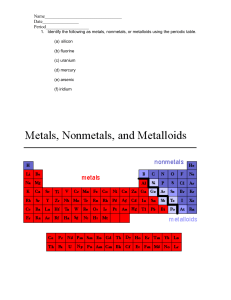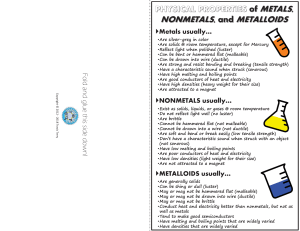science 9 chemistry worksheet 9 metals nonmetals and metalloids 2014-2015
advertisement

Science 9 Unit 2: Chemical Reactions Worksheet 9: Metals, Nonmetals and Metalloids Metals, Nonmetals and Metalloids: Most periodic table contain a staircase line which allows you to identify which elements are metals, nonmetals and metalloids Metals: • • • • • Metals are good conductors of heat and electricity. Metals have a metallic luster (shiny). Metals are ductile (can be stretched into thin wires). Metals are malleable (can be pounded into thin sheets). A chemical property of metal is its reaction with water which results in corrosion. 1 Nonmetals • • • • • Non-metals are poor conductors of heat and electricity. Non-metals are not ductile or malleable. Solid non-metals are brittle and break easily. They are dull. Many non-metals are gases. Metalloids: • • • • • These elements are found along the stair-step line that distinguishes metals from non-metals. Metalloids (metal-like) have properties of both metals and non-metals. They are solids that can be shiny or dull. They conduct heat and electricity better than non-metals but not as well as metals. They are ductile and malleable. PART A: Multiple Choice 1. Which group contains the most elements? (A) (B) (C) (D) 2. Most metals are NOT (A) (B) (C) (D) 3. Ductile. Malleable. Liquid at room temperature. Good conductors of heat and electricity The most useful property of metalloids is their (A) (B) (C) (D) 4. Transition elements Nonmetals Metalloids Metals Varying ability to conduct electric current. Softness and malleability. Tendency to be unreactive. Ability to be pulled out into long wires. Which group of elements shares characteristics with both metals and nonmetals? (A) (B) (C) (D) Halogens Lanthanides Salts Metalloids 2 5. Carbon and other nonmetals are found in which area of the periodic table? (A) (B) (C) (D) 6. As you move from left to right across the periodic table, elements (A) (B) (C) (D) 7. Gases. Dull. Good conductors of heat. Brittle The elements to the right of the zigzag line on the periodic table are called (A) (B) (C) (D) 13. Carbon Sodium Silicon Uranium Metals tend to be (A) (B) (C) (D) 12. Brittle. Metalloids. Good conductors. Shiny. Which element is a metalloids.? (A) (B) (C) (D) 11. Metals. Metalloids. Nonmetals. Semiconductors. Most nonmetals are (A) (B) (C) (D) 10. Noble gases. Isotopes. Alkali metals. Metalloids Most elements are (A) (B) (C) (D) 9. Become less metallic. Have a lower atomic weight. Have a lower atomic number. Become more metallic The three main groups of elements are metals, nonmetals, and (A) (B) (C) (D) 8. On the left-most side On the right side In the middle column of the periodic table In the bottom rows Metalloids. Conductors. Metals. Nonmetals. Most metals are (A) (B) (C) (D) Solid at room temperature. Bad conductors of electric current. Dull. Not malleable. 3 14. Sulfur is NOT ductile, and NOT malleable. Is sulfur a metal, nonmetal, or metalloid? (A) (B) (C) (D) 15. Which is true about metals? (A) (B) (C) (D) 16. It is a metal It is a metalloid It is a nonmetal It is not found anywhere on earth What is O? (A) (B) (C) (D) 18. They are ductile They are malleable They are good conductors of electricity and heat All of the above Silicon (#14) can conduct electricity sometimes, but not other times. It is NOT malleable. What is true about silicon? (A) (B) (C) (D) 17. Metal Metalloid Nonmetal None of the above are correct Metal Metalloid Nonmetal None of the above The only metal that is a liquid at room temperature is ____. (A) (B) (C) (D) Copper Silver Mercury Sodium PART B: WRITTEN RESPONSE 1. Most of the elements that form a zigzag line in the periodic table belong to one major group. What is that group, and what kinds of properties do its elements tend to have? 4 2. Write an “X” in the correct column to indicate whether the element is a metal, nonmetal or metalloid. ELEMENT (A) aluminum (B) calcium (C) antimony (D) cesium (E) carbon (F) manganese (G) fluorine (H) silicon METAL 5 NONMETAL METALLOID



